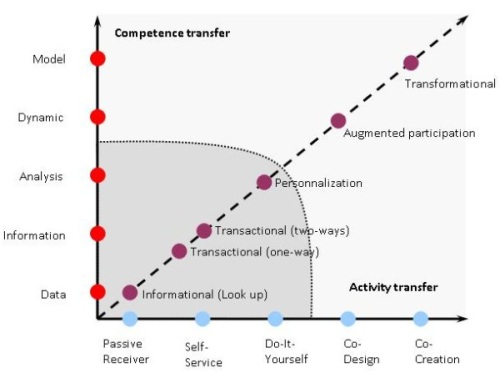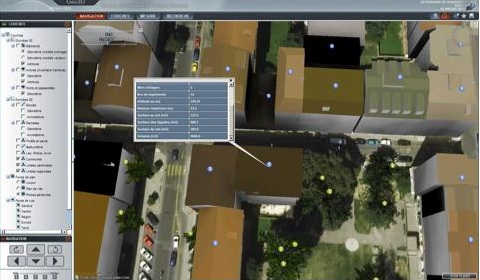Article of the Month -
February 2012
|
Cadastre: Vision for the Future The
Impact of New Dimensions
Dr. Xavier COMTESSE, Avenir Suisse, and Dr. Giorgio
PAULETTO, OT/CTI, Switzerland
1) This paper was presented at
Commission 7 Meeting in Austria, September 2011. The authors state that
in the professions of cadaster both external and internal changes apply
considerable pressure. This paper identifies the major trends that will
most likely have an impact, apprehend the consequences expected and
provide a structure for this development.
ABSTRACT
The environment in which the professions of cadastre evolve has
undergone profound changes. Technological innovation in the digital
field has been considerable. Furthermore, social change has also been
radically altered with, for instance, the emergence of social networks
as a means of transforming our relations. Aside from the present crises,
there have also been great changes in our economic evolution by the
introduction of, on one hand, more flexibility and mobility and, on the
other hand, the advent of globalization of production, work and
consumption.
In addition to these exterior changes, internal changes have also
taken place. These changes are specific to public administrations.
Several trends can be mentioned: the evolution of the public discourse
on transparency and accountability, the opening of public data, the
emergence of the idea of a common good for our human societies. Other
influences also have an impact, for instance, legislative change such as
laws on administrative registers to foster interoperability or
innovative professional software linked to the use of 3D.
These simultaneous changes apply considerable pressure on the
profession. In this paper, we are going to identify the major trends
that will most likely have an impact, apprehend the consequences
expected and provide a structure for this development. We will try to
give a general, coherent and prospective view of the evolution of
cadastre.
Our paper will be divided into three sections:
- Push and pull evolutions
- Six strong foreseeable trends
- Synthesis and conclusion
SECTION 1: PUSH & PULL
Push
With the advent of the World Wide Web, the cadastre has entered
globally in the digital era. This can be seen not only by how we input
data, we look up for it, we store and exchange it, but also by the web
applications nowadays offered to the public and their evolution. The
general public has seen striking examples with Google Maps, Google
Earth, Bing Maps, Street View, Sketch Up, etc. These applications can no
longer be ignored by the professionals because they offer a new way of
reading the territory and they inevitably structure what the public
understands and wants. Similarly, several innovations regarding the use
of these technologies are fundamentally modifying the profession. For
example, let’s mention the “mash up” technique which allows (almost)
anyone to use maps to create new applications, the phenomenon of
geolocalisation through smartphones, the flow of data generated by
individuals, global services accessible through cloud computing offering
platforms and applications or the huge potential offered by the billions
and billions of new IP addresses accessible with the new Ipv6 protocol.
This technological evolution is the first wave we've identified under
the « Push » section for upcoming change. A second one is linked to
global economic change, it redefines the links between producer and
consumer, which overlaps between what is called “hard” and “soft” laws
and also we will see between private and public goods. As they evolve,
these waves of change define new behaviors we will necessarily be
confronted to : copyleft and creative commons which complement classic
copyright laws, the common goods which present different attributes in
the digital world than it does in the physical sense, so called
“prosumers” who actively participate in the design of the product /
service he or she will use, crowdsourcing which uses the ingenuity of
the internet users to create what no other organization could come up
with.
The economy is directly impacted by these profound changes. One only
needs to observe sectors like the music industry, entertainment, the
media, or telecom sector to see this. Doubtless, other economic sectors
will also undergo such significant shifts.
These shifts require the rethinking not only of customer
relationships, but also of the entire business model. It is of paramount
importance to understand that, by entering in the value chain, the
customer transforms all economic relations: we are no longer in a formal
contractual relationship but in a participative transformational
partnership.
The recent events of Fukushima and the Arab Spring clearly show that
the conversations, the media coverage and the spreading of ideas are now
global, almost instantaneous and socially unavoidable. A wind of change
is blowing on the social organization of our society. Networks are
proving to be the tools of this change.
By redefining a social layer based on volunteer work, the lack of
binding constraints and the non-punishable, society is entering in the
era of soft laws. It becomes legitimate, in a certain way, to act even
though there might not be a legal framework to support the action. This
fact will have significant consequences on our societies not only in
public, social and political action but also in professional
applications and services.
Legitimate action has found a legalizing base by bypassing classical
processes. Fields where increased participation has created concrete
examples are a perfect illustration of this change of paradigm: open
source software, open data or linking internet users. Henceforth, acting
with a willingly participating population will allow us to perform tasks
which have so far been intractable for public or private organizations.
We are living this in practical terms with Wikipedia, YouTube or e-bird,
the content of which is created and shared by users.
Thus the participative empowerment fuelled by social networks
redefines not only the social relation to public administration but also
to ownership. Being able to add content to a parcel of official cadastre
becomes a normal expectation for an increasing part of the general
public. How should the owner position himself? And what about the
cadastral systems, which must guarantee the information of real estate
property?
These three « push » components, namely technology, economy and
society, are the catalyze factors of an explosion that will profoundly
change the actual definition of cadastre.
Pull
For the last decade or two, information systems have become more open
and have integrated an increasing participation from people. There are 5
main stages to this evolution:
- informational (look up)
- transactional
- personalization
- augmented participation
- transformational
As mentioned previously, these stages correspond to external changes,
linked to technology, economy and society, but there is more. They also
show a political, legislative and administrative evolution. Indeed, we
argue that both public and private institutions have also evolved from
within, through an inside strength, a « pull », an attempt to adapt to
the evolution of society in order to offer increasingly better services.
The following table illustrates this evolution :
| Stages |
Societal policy |
Laws and regulations |
Administrative / Technical |
| Informational (look up) |
Social responsibility |
ISO 14001 & 26000 Reporting regulations
|
Accountability (transparency & reporting) |
| Transactional |
Productivity |
Laws about standards of information
exchange |
Interoperability (e-Gov) |
| Personalization |
Digital identity |
Laws on personal data protection |
“MyFiles” (e-Id cards, citizen data
vaults) |
| Augmented participation |
Social networks |
Laws on social networks |
Social platforms (e-initiatives,
petitions, forums, voting) |
| Transformational |
Common goods |
Laws on transparency and freedom of
information |
Cloud government (Mash-ups, Open data, API
services) |
Three key “pull” stages determine the change and progress of the
cadastre professions:
- Social issues discussed at the political level,
- Elaboration of laws and regulations to address the political
objectives (International soft laws, European laws, National
parliaments),
- Regulations at a more local level that define the framework in
which the public and private sector can act.
These three stages are interwoven in the political process and,
together, form what we have called the pull process.
This pull process is, in a certain way, an institutional response to
the push process and legalizes the existing (technological, cultural,
economic and so on) behaviors created by society.
General model
Delivering online public services creates two essential transformations:
- An increasing transfer of the administrative activity to
the final user.
- Simultaneously, a competence transfer to the final user.
The figure presented hereafter introduces a "transfer matrix”, which
not only allows the monitoring of the progress made in the availability
of public services ― and therefore benchmarking it ― but also becomes a
strategic management tool. By improving the understanding of the present
and future role of users (citizens, businesses, others administrations,
and civil society organizations) this transfer matrix illustrates the
paradigm shift for the public services.
We are now dealing with a citizen empowerment process that has to be
engaged beyond the simple translation of administrative services into
their online counterpart.

The figure presented above radically transforms the classic approach
by clearly defining the type of activities now transferred to the users
and the competence transfer that accompanies it. Here, we introduce new
sophistication levels: namely the "Augmented participation" and the
"Transformation" levels.
Therefore, the horizontal axis now represents the activity transfer
with the following levels:
- Passive Receiver: The user only has access to structured
information that he or she can discover through search engines or
tree structures.
- Self-Service (One-Way): The user can choose specific documents
and download them.
- Self-Service (Two-Way): He or she can exchange documents or
emails with the administration.
- Do-It-Yourself: The user can perform complete transactions,
including payments.
- Co-Design: Both the user and the administration can personalize
services (e.g. tax forms, etc.)
- Co-Creation: The user can participate in the political and
democratic life of his/her region or country (e.g. the Swiss model
initiative and referendum, forum, etc.)
The vertical axis represents the competence transferred to the user
of the online service. The levels of sophistication vary from raw "data"
to the "model" level, as follows:
- Data: At this level, we deal with raw data or measurements, such
as those produced by statistical services.
- Information: A context is added to the data so that a meaning is
created.
- Analysis: We now can infer a theory from information. This
allows analysis and better understanding of phenomena.
- Dynamic: Time is introduced. The time series add a new dimension
to the previous theory.
- Model: Forecasts can be made from the dynamic theories inferred
by using the information available. Scenarios can be tested and
simulated to forecast the effects of changes and to discuss future
changes.
The 5 levels used in this model are defined as follows:
Informational / Look up:
The user looks up information on the Internet. This phase is
traditionally the first one to be implemented as an online service. This
remains a strong demand from users. With the development of search
engines, the way we look up information has drastically changed. The
menu presentation is superseded by a fast access to information through
these search engines, Google being the leading one.
Transactional One-Way:
The user can download documents. Even though this phase now seems very
basic, it is still essential to the users who manage their documents
electronically. A content and document management system is central to
such activity.
Transactional Two-Ways:
The user can upload documents and send e-mails. It still is nowadays a
major contribution but hasn't reached all levels of the administration,
especially for non structured demands. The user can perform complete
transactions, including payments. This stage is a milestone for
productivity gains and profitability of eGovernment initiatives. It is
underway in most administrations around the world. This stage will be
crucial for a sustainable system since it saves time and money both for
the users and the administration.
Personalization:
The user can use personalized information and transactions. The
documents are pre-filled for his/her personal use. The transaction is
completely secure and customized. This phase will use a key element that
closely resembles a folder called "My Files". It will allow grouping all
of the activities and administrative documents in a single virtual place
that will be accessible at all times. The traceability of the
transactions and activities will become essential to guarantee a sound
accountability.
Augmented participation:
This level corresponds to what may be called a wiki-democracy where
citizens and businesses can initiate change. This is exemplified by
projects such as Open Government initiatives where users are asked to
participate in the development of better administrative services.
Another example is the Swiss initiative where citizens can propose new
laws. In this context too, the U.S. primary campaign lead by Barack
Obama is essentially based on participation. The field is of course very
broad and much is left to explore in order to create new services in a
connected world. Forums, blogs, social networks are only a few recent
examples that have emerged, but most of the field still remains to be
invented.
Transformational:
Co-creation is the key word here, leveraging mash-ups and crowdsourcing.
This level profoundly modifies the concept of "common good" by
redistributing the roles between the administration and the citizens.
The latter are involved in the creation of a new digital administration.
By opening up government data, citizens can transform the way the new
public services are created and delivered. This transformation implies a
redefinition of the "common good" and "public good".
The transformation matrix defined by the transformation along two
axes gives a more complete approach to the evolution and strategy of
eGovernment online services than the classical model. By going beyond a
benchmarking goal, it helps to drive a strategy. The progress of
services can still be analyzed, but the tool now also helps to better
define priorities and explain the evolution of the services. The users
become active stakeholders of the project and not merely final users. By
being turned into a participative partner and not having to adapt to a
forced evolution, the relationship between the administration and its
users changes to better serve the citizen-actor, as well as the
entrepreneur-actor or the consumer-actor.
Section 2: SIX THESES
Trends
We have identified six major trends that will most likely have an
influence on the vision of cadastre.
These trends are linked to technological, economic and social evolution,
and come from the push process described above. They are also part of
the emergent pull process that has begun to appear in several countries.
The six theses presented hereafter influence the entire evolution of the
field in which the cadastre operates. They tell us a story by adding
dimensions not only in geometry but also in meaning.
Thesis 1: The cadastre will include the third dimension of the
landscape and of the objects beyond the current legal framework.
Comment: The technology allows a thorough three dimensional
vision of the land. This is now integrated in several products largely
distributed by companies such Google and ESRI but also Nokia, Microsoft
and several others. This paradigm change raises the issue of height,
ownership and that of co-ownership (e.g. several owners of the different
levels in buildings) and the rights attached to the third dimension such
as for example the right to a view.
Consequence: A new 3D model of the land and of the buildings is
necessary and land surveyors have to take 3D into account.
Thesis 2: The cadastre will blend the strategic map and the
dynamic map of the land to show its historical evolution. Both views
will evolve independently.
Comment: The push of technology makes it possible to store the
information with different time stamps instead of erasing or superseding
it. An animation of the evolution of an object or a region becomes
possible by adding the dimension of time.
Consequence: The current separation between the static object and
the dynamic object will be deeply transformed. A static object becomes a
snapshot at a given moment of its dynamic version.
Thesis 3: The cadastre will be multifunctional and
multijurisdictional.
Comment: The political as well as the technological influence
foster the emergence of functions of a territory. Different regions can
be viewed not only as jurisdictions, but also through the lens of
different functions such as the environmental function, the
transportation function, etc. It therefore will be possible to assess
the impact of policies on different functions and to create many
functional approaches to the territory. Moreover, the interoperability
between various local cadastres will render a change of function
possible upon request.
Consequence: The local cadastres will be blended into larger ones
and include not only jurisdictional views but also functional views.
Thesis 4: Social networks will transform the cadastre.
Comment: The phenomenon of georeference by the public becomes a
more and more normal and accepted tool to extend the cadastre. Almost
all new moving devices include GPS chips (smartphones, cameras, cars,
even cattle!) that can report flows of data. This allows to georeference
the objects and their surroundings in a completely new way.
Consequence: The cadastre will deal more with flows of data and
less with stocks of data.
Thesis 5: New commons will emerge as a referenced object of
the cadastre.
Comment: Data will be more and more made available to the general
public by the administration and, through mash-up techniques, will be
transformed into a new virtual object the « Common Good ». This new
object is a composition of several layers of data and services. It will
create value and be used as a global public good.
Consequence: Both the private and the public sectors will gain
added value by leveraging these new commons. As it is mainly composed of
information, the resource is essentially non-rival (consumption by one
person doesn’t prevent simultaneous consumption by another) and
non-excludable (it is difficult if not impossible to prevent someone to
have access).
Thesis 6: The cadastre will become an essential element of
knowledge society.
Comment: The cadastre follows the same path as society as it
evolves from an information society to a knowledge society. This is seen
through the addition of georeference to many human activities, the
emergence of co-creation by entire crowds, and the body of knowledge
that the cadastre carries enters more and more into models and
decisions. The objects of the cadastre will be part of a feedback loop
that makes its way into knowledge society.
Consequence: Land surveyors will be dealing more with soft fields
of knowledge rather than hard science in the future.

http://etat.geneve.ch/geoportail/geo3d
SECTION 3: SYNTHESIS AND CONCLUSION
This document presents the different thesis that will most probably
change the cadastre professions. We tried to describe how activities and
competencies are shifting from the provider to the end user. Six main
theses are then described by integrating the main trends that can be
seen today as transformational for the cadastre. These trends come form
a push from exogenous shifts (technological, economic, societal) or from
pull shifts (as the public services adapt and operate change).
This is still a work in progress and should be seen above all as a
tool for thought rather than a firm conclusion. It can be used, for
instance, as the basis of a conversation process specifically for
professional software applications. We can anticipate a (r)evolution
towards new dimensions for the cadastre. While leaving behind the map (2
dimensions), the cadastre is going towards far unexplored dimensions. It
is this evolution towards new dimensions that we should work on to
design together with the stakeholders a future cadastre to better serve
society.
CONTACTS
Dr. Xavier COMTESSE
Director
Avenir Suisse
8, quai du Rhône
1205 Genève
xavier.comtesse@avenir-suisse.ch
+41 22 749-1100
Dr. Giorgio PAULETTO
Strategy and Technology Advisor,
Observatoire Technologique, State of Geneva
64-66 rue du Grand-Pré, CP 2285
giorgio.pauletto@etat.ge.ch
+41 22 388-1353
 |



























